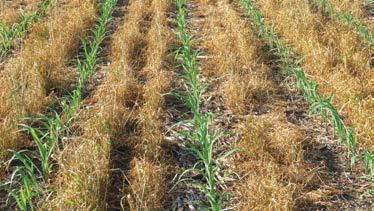SOYBEAN
September - October 2024 - VOLUME XXII - ISSUE 5

A Bright Future Sippin’ on Soy
U.S. Soymeal Arrives in Uzbekistan

September - October 2024 - VOLUME XXII - ISSUE 5

A Bright Future Sippin’ on Soy
U.S. Soymeal Arrives in Uzbekistan
At Asgrow® brand, not only are we all about the beans, we’re all about your success as well. That’s why we o er localized products with leading genetics, weed management systems and maximum pro t potential – all developed by soybean experts who put soybeans rst.
DISCOVER HOW IT’S ALL ABOUT THE BEANS. Asgrow.com
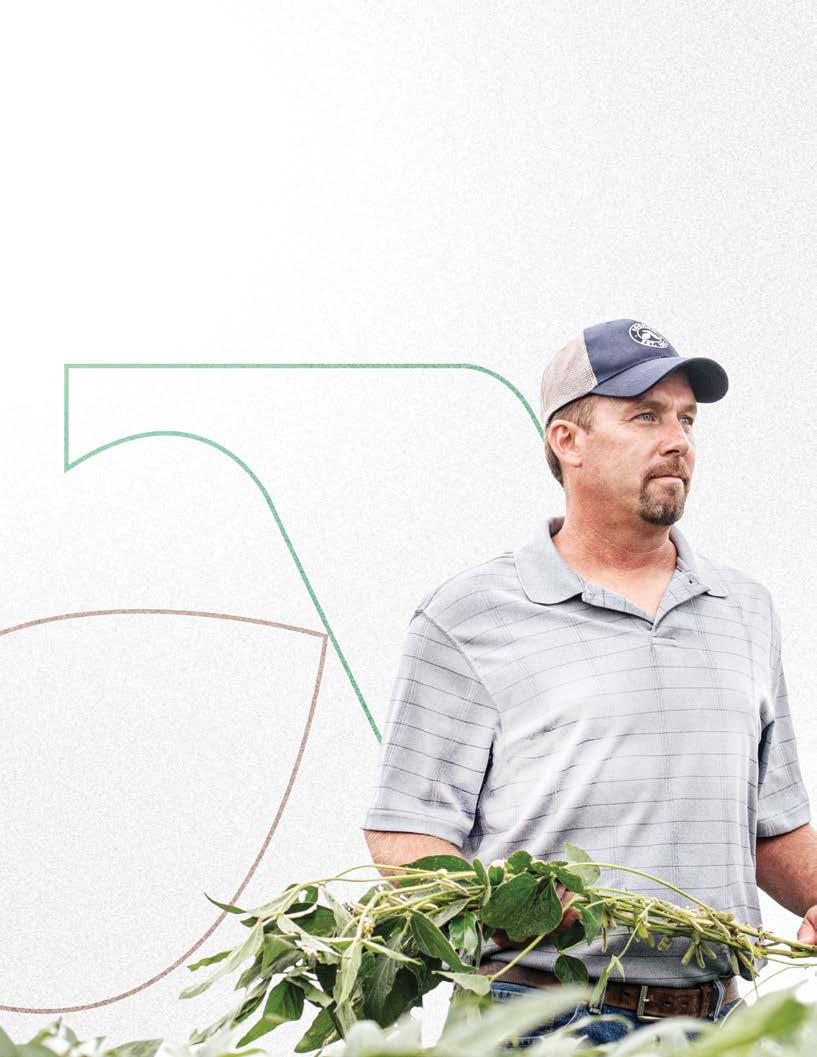





















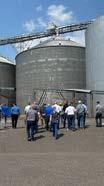

After serving as a Minnesota Soybean ambassador a decade ago, Matt Purfeerst has earned a position on MSGA’s board while building relationships with trade partners.
Minnesota Soybean finished the 2024 Farmfest atop the leaderboard, thanks to increased engagement and a soy-based MiniSoyta golf course that offered fun for the whole family.
Farmer leaders toured the Port of Duluth to continue their quest to ship more soybeans via the Great Lakes St. Lawrence Seaway System. 26
Soy checkoff investments are creating sustainable solutions and helping to extend the life of roofs, one home at a time
Tell the compelling stories behind Minnesota’s soybean farmers and their industry, from the field to Capitol Hill to international markets – and everywhere in between.
OFFICERS
President
Darin Johnson | Faribault County
Vice President
Ryan Mackenthun | McLeod County
Treasurer
Rose Wendinger | Watonwan County
Secretary
Kyle Jore | Pennington-Red Lake Counties
American soybean association Directors
Jim Kukowski | Roseau-LOW Counties
Jamie Beyer | Traverse County
George Goblish | Redwood County
Adam Guetter | Redwood County
Christopher Hill | Jackson County
Michael Petefish | Dodge County
Jeff Sorenson | Redwood County
Bob Worth* | Lincoln County
*Term begins in December 2024.
ASA Young Leaders
Parker Revier & Gabrielle Carmichael | Renville County
County directors
Trevore Brekken | Polk County
Mark Brown | Watonwan County
Steve Brusven | Yellow Medicine County
Jason Cadieux | Kittson County
Brian Fruechte | Lincoln County
William Gordon | Nobles County
Tom Grundman | Douglas County
Ray Hewitt | Le Sueur-Scott Counties
Brad Hovel | Goodhue County
Jim Jirava | Becker-Mahnomen Counties
Mark Knutson | Marshall County
County directors Cont...
Bob Lindeman | McLeod County
Paul Mesner | Murray County
Bruce Nelsen | Mower County
Keith Nelsen | Cottonwood County
Robert Nelsen | Murray County
Tim Nelson | Waseca County
Lucas Peters | Rock County
Vernon Pooch | Pope County
Andy Pulk | Roseau-LOW Counties
Matt Purfeerst | Dakota-Rice Counties
Tim Rasmussen | Otter Tail-Grant Counties
Justin Remus | Brown County
Gary Schoenfeld | Waseca County
Rebecca Sip | Norman County
Joel Schreurs | Lincoln County
Mike Skaug | Polk County
Cal Spronk | Pipestone County
Jamie Seitzer | Nicollet-Sibley Counties
Lawrence Sukalski | Martin County
Jeremy Tischer | Clay-Wilkin Counties
Doug Toreen | Renville County
Earl Ziegler | Blue Earth County
MSGA Executive Director Joe Smentek | jsmentek@mnsoybean.com
Art Director
Doug Monson | dmonson@agmgmtsolutions.com
Sr. Director of Integrated Marketing Ag Management Solutions
Managing Editor
Drew Lyon | dlyon@agmgmtsolutions.com
Sr. Manager of Communications Ag Management Solutions
Layout Editors
Alex Troska | atroska@agmgmtsolutions.com Kaelyn Rahe | krahe@agmgmtsolutions.com
ADVERTISING
Sales Manager
Erin Rossow | erossow@agmgmtsolutions.com 507-902-9191
Advertising space reservations can be made by the 15th day of the month prior to publication. In consideration of the acceptance of the advertisement, the agency and the advertiser must, in respect of the contents of the advertisement, indemnify and save the publisher harmless against any expense arising from claims or actions against the publisher because of the publication of the content of the advertisement.
Soybean Business is published six times a year on behalf of Minnesota Soybean. Comments and suggestions can be submitted to: Minnesota Soybean Growers Association, 1020 Innovation Lane Mankato, MN 56001

Advertisements within this publication contain the opinions and information of the advertisers and do not necessarily reflect the opinions or views of the Minnesota Soybean organizations or affiliated groups. mnsoybean.org

I’ve heard it said before, and it bears repeating: As the newest president of the Minnesota Soybean Growers Association, I am proudly standing on the shoulders of advocacy giants. For more than 60 years, our farmer leaders built MSGA into a nationally respected advocacy organization, and many of those farmers have since gone on to national leadership roles. From our first president, John W. Evans to my predecessor and friend, Bob Worth, I am humbled, honored and energized to lead this esteemed organization in the year ahead. I’m also fortunate to collaborate with a dynamic officer team, along with our entire board, Executive Director Joe Smentek and our talented staff, and a lobbying team that knows the inner workings of the Capitol like few others. A tradition of excellence and professionalism has been set at MSGA, and I promise you I’m working hard each day to reach (and hopefully exceed) that bar.
Serving as president of MSGA is not about me; the purpose is far greater. Being president of MSGA means I’m not just representing myself as a fourthgeneration farmer and seed business owner from Wells. Alongside our board and staff, I’m representing all our members and Minnesota’s over 25,000 soybean farmers on the policy issues that matter to your businesses. And there is no shortage of policy priorities to tackle in St. Paul, Washington D.C., and internationally. Throughout my presidency, we’ll use our resolution process and work tirelessly to protect crop production inputs; support the growth of biodiesel and sustainable aviation fuel; promote our sustainable practices; grow the farm economy; and develop new markets across the globe while also protecting key trade relationships. Let’s go!
Of course, advocating for farm-friendly legislation is at the heart of MSGA’s mission. As political observers, you can bet we’ll be keeping a close eye on the election results – at both the state and national levels. There are a lot of scenarios in play: The entire Minnesota House is up for election, and Democrats are looking to protect their four-seat majority; not to mention, Gov. Tim Walz is campaigning for vice president of the United States.
While MSGA is nonpartisan and refrains from endorsing candidates, a split government usually means legislative compromise and would likely be the most favorable outcome for farm advocacy groups. It’s anyone’s guess how these results will shake out. But rest assured, no matter who emerges victorious, we look forward to engaging with new and returning lawmakers in 2025 to work to make a challenging farm economy more profitable for our farmers and industry partners.
As someone who’s been affiliated with MSGA for over two decades, I know how important it is to support our organization through membership.
During one of my first acts as president, I met with many past, present and future MSGA members during Farmfest to learn more about their issues and their passion for MSGA and our industry. I share their dedication to our profession and look forward to living up to the standard set by those leaders who came before me.
Until we meet again, I wish you all a safe harvest –and be sure to have your voice heard at the ballot box.
Darin Johnson President, Minnesota Soybean Growers Association
This column is a series in Soybean Business featuring leaders from the Minnesota Department of Agriculture.
As the saying goes, “If you don’t like Minnesota’s weather, wait five minutes. It’ll change.” The same could be said for farming. Science and technology have revolutionized agriculture over the past decade with high-powered drones, advanced genetics, mapping solutions, and more. Changes will likely continue at an even quicker pace. This isn’t a bad thing. And while we may wait around for better weather, we need to utilize the latest tools we have now to shape our farming operations and improve our state’s natural resources for decades to come.
For instance, we’ve seen positive outcomes when it comes to reducing nitrate loss and improving nutrient management, which is particularly important with the geology of southeast Minnesota and other parts of the state. Those outcomes are thanks in part to the Minnesota Ag Water Quality Certification Program, Root River Field to Stream Partnership, Nutrient Management Initiative, and other Minnesota Department of Agriculture programs. Active participation by farmers is critical to the success of these programs. When the ag community
is involved in problem solving at the local level through these initiatives, we can all work together to see benefits on Minnesota cropland. Cooperation and partnerships are also key to taking the latest in agriculture and shaping our future. As an example, Minnesota’s Soil & Water Conservation Districts are important partners in delivering technical and financial assistance for conservation practices. Their staff can easily connect you with valuable resources that benefit our soil and water. Farmers are also banding together to purchase soil health equipment through programs like our Soil Health Financial Assistance Program. The soil health grants help fund new or retrofit existing equipment. A group of farmers working together through the program can ease costs and bring a regenerative ag approach to several farms at once. By reaching across the fence rows, we can come up with new ideas and opportunities that improve our natural resources and the bottom line.
Finally, we can take the latest technology and utilize outstanding programs and partnerships to make
TO LEARN MORE ABOUT THE MDA’S INITIATIVES, VISIT MDA. STATE.MN.US AND FOLLOW THE DEPARTMENT ON X AT @ MNAGRICULTURE.
improvements right now that will have positive benefits for years to come, but it doesn’t do much good if we aren’t sharing what we do. Tell your neighbor about your success with a new conservation practice or how effective a recently implemented best management practice has decreased your inputs. Better yet, tell your non-farming friend how you’ve utilized the latest in science to improve water quality or better equip your soil to deal with heavier rains. We’re our own best advocates.
Speaking of rains, two years of drought followed by this year’s constant storms shows us how much our weather patterns can fluctuate. That’s why we need to make

wait for Mother Nature to change.
By Bailey Grubish and Kelsey Barchenger
From an ambassador internship with Minnesota Soybean to becoming a Minnesota Soybean Growers Association (MSGA) director, one farmer’s leadership development is leading to a long-lasting impact.
Between Matt Purfeerst’s freshman and sophomore year at South Dakota State University (SDSU), he returned home to Rice County to work on the family farm. He knew he wanted to stay connected to the industry, which made the ambassadorship with Minnesota Soybean an ideal fit.
“I didn’t really know what I was getting into when I applied for the ambassadorship (with Minnesota Soybean),” Purfeerst said. “And coming out of it, I learned a lot. I was able to sit in on board meetings, I was able to sit in with the directors and I
was amazed at what they were doing behind the scenes. I kind of felt bad that I had no idea how active they were. I kind of stumbled into it. And I was very glad that I did.”
During the ambassadorship, Purfeerst learned the business side of Minnesota Soybean and gained friendships and connections.
The experience eventually led to Purfeerst’s appointment as Rice County’s representative on MSGA’s board in 2023.
Purfeerst became friends with his fellow Minnesota Soybean ambassadors. He even attended SDSU with Danielle Evers, an MSGA member who now works as an area certification specialist with the Minnesota Agricultural Water Quality Certification Program.

In the soybean world, there are only a few degrees of separation.
“I went to two board meetings (as an ambassador) and now as a director,” Purfeerst said. “It’s just funny seeing the people that ran the board then are still on the board now. It’s kind of full circle to a degree.”
During his childhood, Purfeerst’s local Dakota-Rice County Corn & Soybean Growers board was very active in Purfeerst’s community and the board continues staying engaged. Through his local board and his subscription to Soybean Business, Purfeerst learned of the ambassadorship, and he decided to apply.
As a Minnesota Soybean ambassador, Purfeerst attended several events on behalf of the organized soybean county program. He also attended events such as Farmfest, the Minnesota State Fair, MN Ag Expo, MSGA board meetings, Biodiesel Open, truck and tractor pulls and county fairs. His role was more focused on the Minnesota Soybean Research & Promotion Council (MSR&PC) and the soy checkoff, but he also learned how MSGA advocates on behalf of soybean farmers.
“The biggest takeaway for me is how much work behind the scenes was going on at that time,” Purfeerst said. “It was a great experience. I learned a lot.”
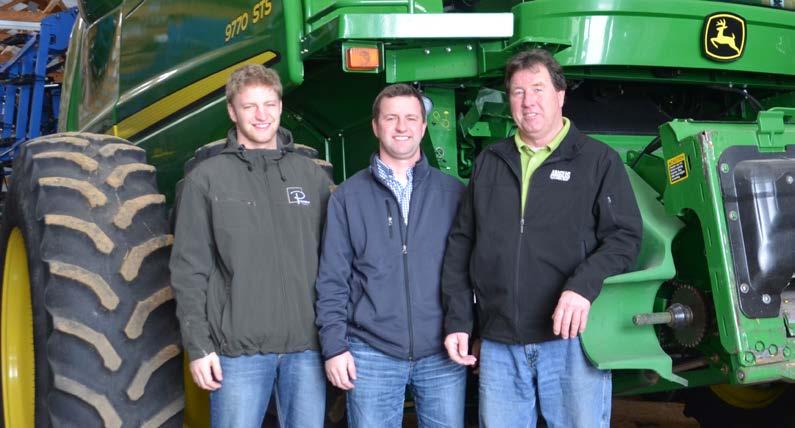
He said one of his favorite aspects during his time was driving biodiesel trucks in the parades around the state for county soybean boards. Purfeerst also made connections with the farmers and those who attended events, growing his network.
“Matt, like many of the ambassadors, was a wide-eyed farm kid wanting to make an impact in the industry,” said Doug Monson, Minnesota Soybean’s senior director of integrated marketing and Soybean Business art director. “He worked hard and always did so with a smile. For me, it’s fun to see his passion come full circle as an MSGA director.”
Watching the business side of MSR&PC and MSGA partly inspired Purfeerst to pursue a degree in ag business with a minor in agronomy. He credits the ambassadorship as a stepping stone toward an internship at Cargill, where he accepted a job after college before returning to farming full time.
A fifth-generation farmer, Purfeerst grows a soybean and corn rotation with beef cattle and show cattle in Rice County. He farms with his wife, Alyssa, dad, Jim, and brother, Mark. Purfeerst hopes to pass down the farm to the sixth generation.
“I farmed with them my whole life growing up, so we know each other all pretty well, know each other’s strengths and weaknesses,” he said. “It’s actually a really good fit for us. The ultimate goal is just to keep it going and hopefully someone’s interested in it. And if not, that’s okay, too.”
After his internship ended and he returned to farming, Purfeerst wanted to continue promoting the agriculture industry. He just didn’t know exactly how he was going to do that, until the opportunity arose during his first county board meeting.
“I reached out to some of the board members, and I made my first meeting (in 2022),” Purfeerst said. “And from that meeting, I got to be the director at the state level. It’s kind of just learning, drinking out of a fire hose a little bit. They’re going to get me involved; the purpose of being on the board is to be active and to help out the best I can. It’s a unique experience.”
As a MSGA director, he appreciates the part each director contributes to the board. MSGA is devoted to standing up for farmers, and Purfeerst is excited to engage with legislators and participate in legislative Hill Visits.
He’s also joined a few MSGA internal committees, including action teams focused on policy, industry relations and promoting emerging leaders.
When in doubt, Purfeerst is turning to the experts.
Continued on page 10
“I’m pretty new to the board,” he said, “but there have been some farmers that have been on that board for a long time, which is great. They have a ton of experience. They understand how the political machine works with the most important people, where our allies are. So, it’s great to see that, and having experienced farmers on the board is crucial. Hopefully I can get there someday, too. Everyone plays their own key role.”
In July 2024, Matt and Jim Purfeerst hosted a nine-person trade delegation representing China’s swine industry. The Purfeersts took attendees on a tour of modernized farm equipment and a walk out to the field to analyze the 2024 soybean crop.
In 2023, China purchased over $18 billion in U.S. soybeans. Roughly one in three rows of soybeans in Minnesota goes to China.
“My goal is to show them that we are responsibly raising our crops,” Purfeerst said. “China is a huge trade
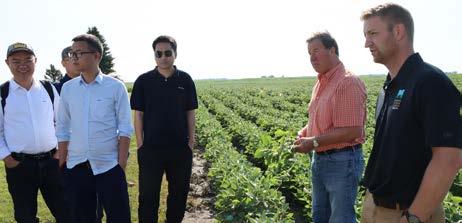
partner with us, so they’re taking a lot of our soybeans every year. We hope they are able to understand that we’re growing them right. We really appreciate the business they’re providing for us, because without them I don’t even want to know what the price of our soybeans would be.”
Calculators were on hand to convert Minnesota’s farmland acreage to hectares to help trade mission attendees wrap their minds around the soybean-filled landscape and
how many of those soybeans head overseas to their home country.
The visit wasn’t just a learning opportunity for attendees. Purfeerst found it equally rewarding to visit with buyers.
“We need to continue building partnerships with other countries,” he said. “That ultimately helps our demand, so it’s great they’re coming here, and hopefully we can continue going over there and keep building that bond.”

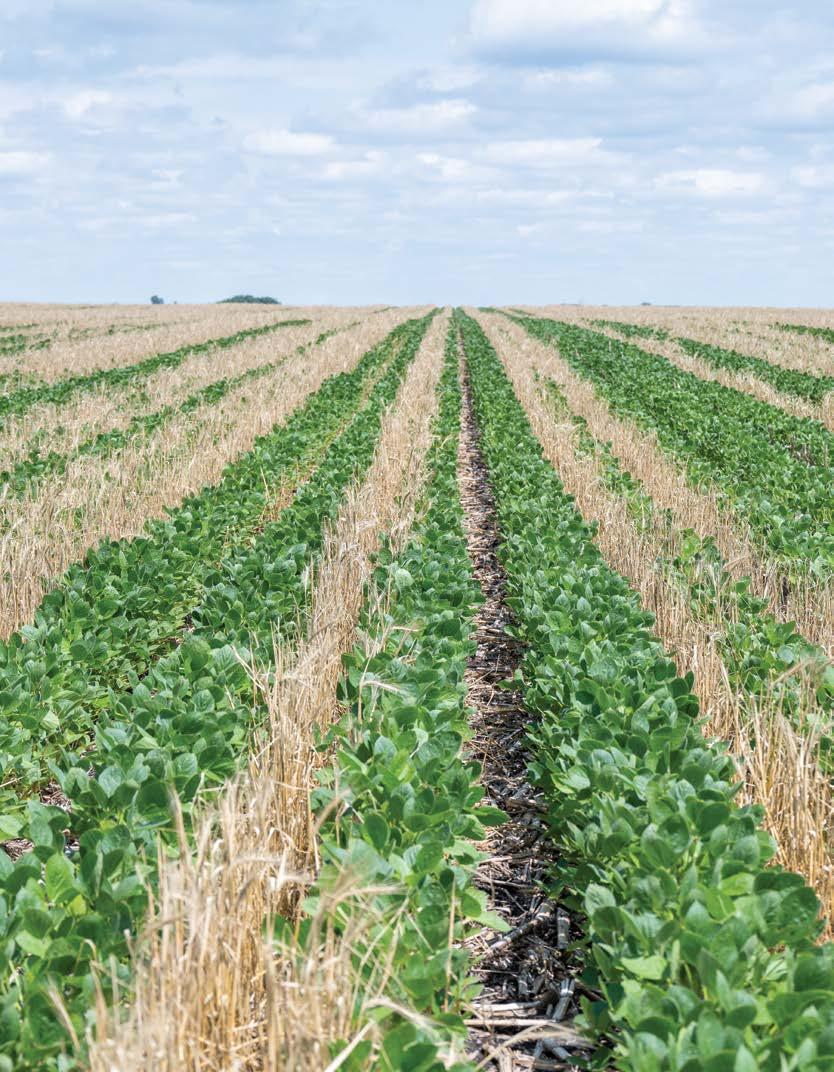
Danielle Evers found her career’s path, and a growing passion for soil health, through enrolling farmers in the Minnesota Agricultural Water Quality Certification Program (MAWQCP).
Raised on a Cottonwood County farm, Evers studied agronomy at South Dakota State University. After an ambassadorship with Minnesota Soybean, she interned at the Cottonwood County Soil and Water Conservation District office. That position led Evers in 2016 to learn more about MAWQCP’s newly created southwest Minnesota area certification specialist (ACS) position.
“My boss at the Soil and Water Office in Cottonwood thought that, with my background, that would be a good fit for me,” she recalls. “I definitely had to put my learning cap back on.”
The rest is soil health history. When Evers started her role, MAWQCP had enrolled only about 104 farms across 60,000 acres. Eight years later, the Minnesota Department of Agriculture recognized Evers in summer 2024 as MAWQCP’s first ACS to certify 200 farms. In total, she’s assisted farmers in enrolling nearly 140,000 acres into the one-of-a-kind program – roughly 12% of all the qualifying acres throughout Minnesota.
Evers credits financial incentives, the industry’s growing interest in sustainable practices and MAWQCP’s positive word of mouth among producers with increasing MAWQCP’s coverage.
“The program offers a lot of benefits – we have a lot of different funding opportunities with the Soil and Water Conservations Districts that we partner with,” says Evers, who’s based in Pipestone County. “Cover crops, strip-till and no-till: all those practices seem to be gaining traction and go hand-in-hand with our program. We have people just walking in the door because they’re passionate about conservation in general and learning more about the program.”

Serving southwest Minnesota, Evers has helped enroll several farmer leaders from the Minnesota Soybean Growers Association (MSGA) and the Minnesota Soybean Research & Promotion Council.
“It’s just awesome to have the support industry, because MSGA has a broader reach to the general farming population,” Evers says. “We’re really thankful for the people and leaders who are willing to install some of these practices on their own.”
When a producer volunteers to become MAWQCP certified, they’re connected with their regional ACS, who helps guide them through enrollment. The ACS first collects information on the operation and then starts the evaluation process. In total, MAWQCP supports eight ACS across the state, in addition to a team of certifying agents.
The MAWQCP assessment tool the specialists follow typically involves evaluating:
• Physical field characteristics
• Nutrient management factors
• Tillage management factors
• Pest management practices
• Irrigation and tile drainage management
• Conservation practices
“The most heavily weighted are tillage and the nutrient management aspects because that’s where our main risk to water quality comes from,” Evers says. “I do try to make it as easy on producers as possible. We want to value their time.”
Since the voluntary program’s statewide launch, 1,518 producers totaling over 1,095,000 acres have been certified across Minnesota. Those farms have added over 2,940 new conservation practices. New practices have helped reduce greenhouse gas emissions by over 50,000 metric tons annually and have kept nearly 48,000 tons of sediment out of Minnesota rivers while saving 144,000 tons of soil and 60,000 pounds of phosphorous on farms each year. The conservation practices have also reduced nitrogen loss by up to 49%.
Once Minnesota farmers apply for MAWQCP certification, an ACS helps complete a series of steps using a 100% site-specific risk-assessment process. Specialists like Evers can also help farmers apply for financial assistance and MAWQCP’s Climate Smart Project. After becoming certified, farmers receive a 10-year contract ensuring they will be deemed in compliance with any new water quality laws, along with an official MAWQCP sign to display on their farm and other benefits.
Farmers and landowners interested in becoming water quality certified can contact their local SWCD or visit MyLandMyLegacy. com. If you farm in southwest Minnesota, contact Danielle Evers at danielle.evers@pcmn.us or by calling 507-221-0304.





Minnesota Soybean completed its round at Farmfest with a full scorecard. By engaging with farm families, industry professionals and legislative leaders, farmer leaders rolled out a green carpet and played their part in promoting the soy checkoff’s ongoing ROI, along with driving home advocacy priorities.
More than 800 golfers of all ages experienced the soy-backed mini golf course at Farmfest.
At least five candidates running for election visited the MSGA Farmfest booth, including Sen. Amy Klobuchar.
More than 30 state and federal legislators visited MSGA’s Farmfest booth during the three-day event.


MSGA broke its record for memberships added at Farmfest with 63 new or renewed memberships.
25 people signed up for a new three-year MSGA membership
26 people renewed their three-year MSGA membership
5 students signed up for an MSGA membership




The media got an exclusive look at the SYNLawn turf at Minnesota Soybean’s first-ever media day event prior to Farmfest’s official opening Aug. 6.
The purpose of the media day event was to give the media an opportunity to share Minnesota Soybean’s message on the value of the soy checkoff and new uses for soy, which they experienced firsthand on the soy-backed course.

Over the three-day event, more than 15 media interviews were conducted by media outlets statewide.
Sharing the message of soy: Stories at Farmfest reached an audience surpassing 30,000 people.

Bruce Potter, pictured here at MN Ag Expo, is calling it a career after more than 25 years studying pests at the University of Minnesota.
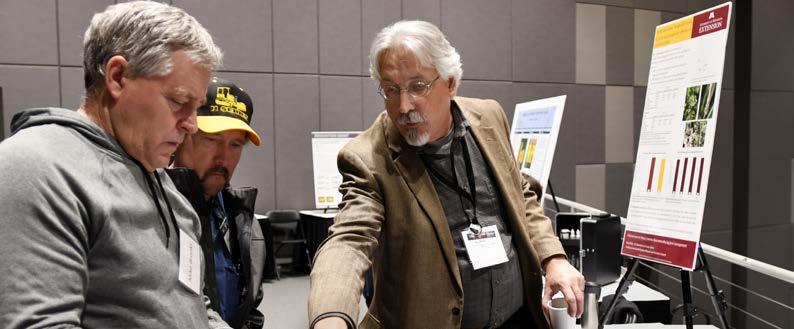
By Mark Askelson
Since 1997, Bruce Potter has researched pests for the University of Minnesota (UMN), but the interest in those pesky little critters began when Potter was just a young kid with a magnifying glass.
“Some of the earliest memories I have as a young kid were studying ants trying to figure out why and how they can go from point A to point B,” Potter said. “Later in life I was planning to be an architect, but then I discovered you can get a whole degree from the University of Minnesota studying insects, so I was all in.”
Now after a more than 25-year career as a UMN Extension Integrated Pest Management (IPM) Specialist, Potter is retiring and swapping the magnifying glass for a fly-fishing rod.
Potter, who began his career in the private sector, has helped play a key role in several major pest and disease discoveries and research studies during his career at UMN and the Southwest Research and Outreach Center (SROC) in Lamberton. His work encompassed projects related to developing the economic threshold for soybean aphids to white mold research and even discovering new pests in Minnesota.
“He’s been Johnny on the Spot throughout his whole career. Bruce was the first person to report soybean gall midge in Minnesota down on a farm in Rock County,” said David Kee, Minnesota Soybean Research & Promotion Council director of research. “But more importantly, he’s an extremely competent entomologist and IPM specialist with the ability to focus through the complex issues of pest management and determine the root of the issue.”
Over the years, Potter developed a strong relationship with MSR&PC. With checkoff support, MSR&PC funded at least one of his research projects every year since he started at UMN.
“I’ve seen a lot of new pests and diseases in Minnesota during my time, so a lot of my research involves studying and getting to know them and then watching their resistance develop over time,” Potter said. “MSR&PC has been a great partner in funding those initial research projects when those problems arrived.
“Working on-farm and interacting with the farmers has been some of my greatest memories and experiences.” -Bruce Potter
Potter was also a regular speaker during the Brown County Corn & Soybean Growers Board’s annual meetings.
“Bruce was always entertaining and delivered a lot of important research to our county board,” said MSR&PC Director Cole Trebesch, who farms in Brown County. “Our checkoff support of his research brought a lot back to us when it came to pest management.”
For the future researchers who will come along after him, Potter offers advice.
“First, be willing to listen and second, know what you do not know,” he said. “That’ll help you design experiments, and it’ll help you figure out the quickest way to solve the problem.”
While technically retired, Potter is finishing up publications from his recent research work and hopes to continue to research part time with UMN and in the private sector.
“Working on-farm and interacting with the farmers has been some of my greatest memories and experiences,” he said.
By Kelsey Barchenger
A small, slender fly has soybean researchers landing in a state of concern.
Through soy checkoff-funded research, scientists have been carefully writing their playbook to defend against soybean gall midge, a species that attacks soybeans in the Upper Midwest. Since its discovery in 2018, the soybean gall midge has made its way to the southwest corner of Minnesota.
“It has the potential to be an extremely damaging pest,” said David Kee, director of research with the Minnesota Soybean Research & Promotion Council. “It is extremely damaging in Nebraska and Iowa, but we don’t have a big enough population here for it to be that way yet.”
Signs of soybean gall midge
The symptoms of soybean gall midge are identifiable after the V2 soybean growth stages. The most obvious signs include larvae underneath the epidermis of the soybean stem, typically at the base of the plant and dark discoloration at the base of the stem.
“We’ve been working diligently with certified crop advisors to be on the lookout for it,” Kee said. “We’ve done surveys, and more are underway.”
Infestations are most likely on field edges near fields where soybeans were planted the previous year.
While it has yet to settle too far into Minnesota, soybean gall midge has made an impact in the Upper Midwest, leading to stunting, wilting and even the death of soybean plants. The University of Minnesota (UMN) has also recorded yield reductions, especially on field edges.
“Prior to 2017, it was a completely unknown insect, with zero documentation on it,” Kee said.

There are at least two generations of soybean gall midge each growing season. Photo courtesy of Daren Mueller, Iowa State University, Bugwood.org
“So, it’s important to note that we’ve got less than a decade of knowledge on this beast.”
With little information about this pest, what does the defense playbook look like for researchers? UMN Extension has been hard at work to lay out its game plan.
“There is new research being done both culturally and chemically, all methods of control,” Kee said. “We’re also doing more in-depth research on what temperature it needs for it to survive Minnesota winters.”
Kee said research has found that for short-term exposure, soybean gall midge can survive in negative 40 degrees Fahrenheit, while its longterm survival rate is still being conducted.
“Our biggest concern right now is, how do we control this if we get populations large enough to be economically damaging?” Kee said. “The more we know about it, the more we can figure out how to control it.”
If you suspect you have a soybean gall midge infestation, contact UMN Extension researcher Robert Koch at koch0125@umn.edu.
“Soybean checkoff-funded research has provided much of what we know about this insect,” retired UMN Extension Researcher Bruce Potter said.
MSR&PC gathers stakeholders, looks ahead
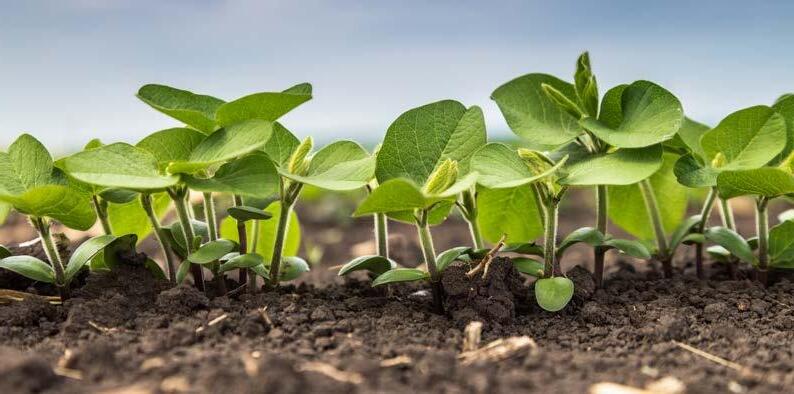
By Kaelyn Rahe
The foundation for the future is constructed in the present.
That mindset is top of mind for the Minnesota Soybean Research & Promotion Council (MSR&PC).
“The soybean industry is continually faced with new challenges,” MSR&PC CEO Tom Slunecka said. “The checkoff is always thinking ahead on how we can be more effective and proactive, not only for our soybean farmers, but the researchers.”
Enter the Future of Soy Summit. This biannual meeting connects farmers, industry leaders and researchers to look toward the future, challenge the status quo and address these issues.
Every leadership path looks different, but they all start with a step.
For current Minnesota Soybean Growers Association (MSGA) Vice President Ryan Mackenthun, leaping into leadership meant immersing himself in topics outside his comfort zone.
“I remember walking into one of my first board meetings and they were talking about dredging the Mississippi River,” Mackenthun said during an emerging leader panel. “I felt like I was in way over my head, but after a few meetings and a few discussions with other directors, I quickly became more engaged with the happenings within the organization.”

For MSR&PC Vice Chair Gail Donkers, her pathway to leadership meant connecting with likeminded colleagues.
“It is important to find your people,” Donkers said. “And that is what (Minnesota) Soybean has done for me.”
Donkers credited her family and her job at Minnesota Farmers Union in encouraging her ability to volunteer.
“I was told when I first started my job at Minnesota Farmers Union, ‘Your position at Minnesota Soybean is just as important as your job at Minnesota Farmers Union. ... because you’re fighting for Minnesota farmers every day you are working there,’” she said.
The future isn’t just the challenges the soybean industry faces, but also the next leaders making those decisions to increase soybean profitability. The Summit not only brings current directors to the table but identifies potential leaders.
Meeker County soybean farmer Cole Anderson’s leadership track started at the Young & Emerging Farmer Workshop program launched with checkoff support at the 2024 MN Ag Expo.
“I wanted to learn how everything is affiliated, and learn the direction soy is moving forward, too,” Anderson said. “We’re trying to make things better for all aspects of farming.”
Kelsey Henke has grown her leadership skills through being a member of the Nicollet-Sibley County Corn & Soybean Growers board and volunteering in Minnesota Soybean’s Farmfest booth.
“I looked at this as an opportunity to grow what I can do for our county and eventually do for the state level,” Henke said. “I am here to soak up as much as I can to be better in the future.”
The pesky pests, wacky weeds and damning diseases all pose challenges to farmers. Farmers continue striving to combat these yield-robbing issues, along with developing new varieties. Those goals can’t be achieved without checkoff-supported researchers.
“Soybean breeding takes a long time,” said Aaron Lorenz of the University of Minnesota (UMN), “and those projects need to be started right now.”
The Summit hosted rotating Table Talks to bring together farmers, researchers and industry leaders to engage on current and future issues.
“What I like best about the Summit is the conversation between researchers and farmers,” said Tom Frisch, MSR&PC chair. “Through those discussions, the soy checkoff can be invested more strategically on behalf of the state’s farmers.”
Researcher Aaron Lorenz oversees the University of Minnesota’s soybean breeding program, which the soy checkoff has supported for more than 40 years.

Soybean Breeding/Genetics
Agronomy/Physiology
Disease Management
Insect Management
Weed Management
Nutrient Management
Biobased Product Adoption
Triggers to Adoption of New Animal Feeds
“We need to think about the crops we grow just a little bit differently,” Slunecka said. “We need to better explore the interconnectivity of researchers out in the field and the researchers that are developing products from our crops.”
SoyFoam, Goodyear tires and Skechers shoes are just a few examples of soy-based products that started with a futuristic concept and developed into the products they are today. Currently, with checkoff support, more than 1,000 soy-based products are commercially available. Other panel topics included presentations from UMN researchers on emerging agronomic issues, the biobased economy and ag’s futuristic concepts.
Following the Summit, farmer leaders and researchers take the information they obtained and build ideas to solve problems they face now – and problems potentially facing them in the future.
“The future is soy,” Slunecka said. “Our goal is to increase soybean profitability and by hosting the Future of Soy Summit, we are bringing in the key players to help move ag forward.”
Donkers hopes future leaders were inspired by what they learned.
“It’s that spark we have to ignite in somebody to be interested in what we’re doing and push the Council forward,” she said.


There is a relentless spirit that unites us all in agriculture - a conviction we can dream big and that together, we become unstoppable.
As iron sharpens iron, so one person sharpens another.
Proverbs 27:17 NIV
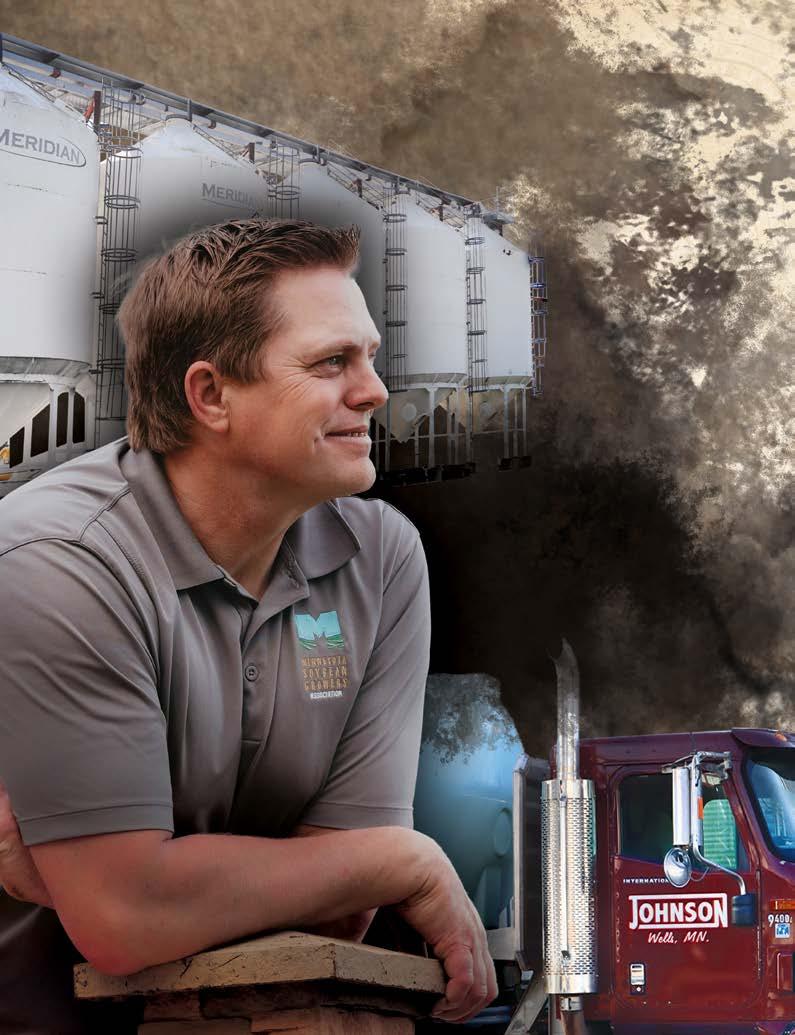
Darin Johnson navigates numerous roles

By Drew Lyon
Depending on the hour (or rather, minute), Darin Johnson is a farmer, agriculture advocate, seed business owner, husband, father, friend, pilot and/or radio show host.
“A typical day sends me in 150 different directions,” Johnson said during an August morning at his farm just north of I-90 near Wells. “Sometimes there aren’t enough hours in the day.”
Yet through life’s triumphs and tribulations, Johnson maintains a practical outlook and smile on his face while pushing himself and colleagues to be the best in their fields. When farming leaves him frustrated – like when excessive rainfall drowned out his fields in summer 2024 – Johnson rolls with the punches.
“That’s farming,” he’ll say with a shrug.
Johnson’s mindset hasn’t changed much since childhood, said fellow farmer Jeff Ignaszewski, a close friend since grade school.
“Knowing Darin, he doesn’t settle. He’s always looking to improve and keep moving forward in a positive way,” Ignaszewski said. “I’m super proud of how far he’s come.”
Johnson’s dance card is only getting fuller. After two years serving as vice president under Bob Worth, Johnson was elected by his peers to serve as president of the Minnesota Soybean Growers Association (MSGA). In his new role, Johnson is tasked with leading a proud organization representing the advocacy interests of Minnesota’s nearly 26,000 soy farmers.
Continued on page 24
He’s ready for the challenge.
“It’s really an honor to be president of MSGA,” said Johnson, who farms with his uncle Scott, his wife, Rachel, and their family. “My job is to make sure growers feel good about where we’re going as an industry, and that’s a role I take seriously.”
A tradition of advocacy
Johnson was “voluntold” by his uncle Scott and late father, Charlie, to join the Faribault County Corn & Soybean Growers Board more than 20 years ago. Once the baby-faced youngster, he paid his dues. After recruiting friends and colleagues over the years to fill vacancies left from retiring directors, Johnson has become an elder statesman on the proactive, 12-member county board.
“Our board keeps getting younger,” said Johnson, who still serves as county chair. “They’re all very involved.”
Johnson joined MSGA’s board seven years ago. He endeared himself to colleagues through his friendly demeanor, eagerness to learn and a desire to speak up for his industry.
“Darin is what makes MSGA great, the family farmers who step up and take the time out of their busy lives to help improve the situation for all Minnesota farmers,” said Joe Smentek, MSGA executive director. “He’s continuing that tradition.”
Johnson studied the issues by learning from experienced leaders and hosting numerous trade teams and legislators,
including a presidential candidate; he also drove through a snowstorm to represent MSGA at the Capitol. His advocacy experience made Johnson ready to serve as president on Day One, Worth said.
“He’s a great person to be president of MSGA,” Worth said.
“Darin is engaged and can communicate well. He’s so fun to work with. He’s got such a good handle on everything.”
Darin’s daughter Tyra is a pilot with Sun Country Airlines. Tyra later helped her dad earn his private pilot’s license in 2022. Darin now saves time and clears his head by flying the friendly skies to MSGA events, including July’s Future of Soy Summit and his first board meeting as president in Duluth.
“Flying is one of those things, for me, it’s a challenge but it’s calming and freeing,” he said.
Ryan Mackenthun, who serves under Johnson as vice president, said his colleague is universally respected among his peers not just because of his friendly disposition, but his passion for agriculture.
“It takes your mind off everything else because you have to have the right mindset.”
“Darin embodies the leadership qualities that MSGA needs,” Mackenthun said.


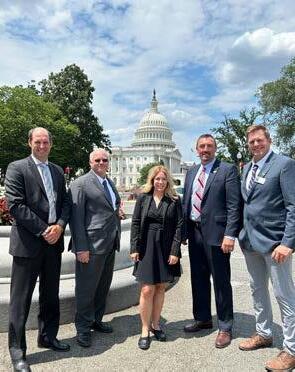
“He represents not just his own perspective but serves as a true advocate for all soybean farmers in Minnesota. His deep respect among peers and commitment to the cause make him an invaluable asset, and I look forward to working with him in championing the interests of our soybean community.”
Breaks in the clouds
Johnson isn’t wearing rose-colored glasses. He knows the farm economy has hit a roadblock for myriad reasons, including high interest rates, input costs and weather calamities. Stormy clouds also loom with another trade war with China possible in 2025.
He’s staying optimistic but isn’t naive, either.
“We’re moving into some tough times, and success to me would mean persevering through these tough times,” he said.
A core priority of his presidency lies in expressing to legislative leaders and policymakers the importance of agriculture to our economy, environment and national security.
“It’s missed sometimes what it takes to put a crop in, the amount of capital it takes,” he said. “There’s a lot of good faith in farming, and hopefully we can share that story. “
Ignaszewski said he knows one faux pas his friend won’t commit.
“Darin is very big on not burning bridges,” he said. “It’s important to him to keep good relationships.”
Johnson has dove headfirst into his new position. In his first two months as president, he met with lawmakers in Washington, D.C.; attended Minnesota Soybean functions; represented MSGA throughout Farmfest; engaged with biodiesel stakeholders and USDA Sec. Tom Vilsack in Minneapolis; and planned to host a Chinese trade team visit that Ignaszewski ended up hosting only because Johnson was helping his son, Aaron, move into college.
There’s no time to waste.
“We’ve got a great team here at MSGA,” he said, “and we’ve got to get back to work.”
Johnson also co-hosts a radio program, “Growing with Johnson Seeds,” which airs Wednesdays at 11:35 a.m. and Thursdays at 10:30 a.m. on KBEW
98.1 FM in Blue Earth. He anticipates his MSGA duties will require him to call in remotely more often in the year ahead.




By Drew Lyon
What’s old is new again at the Port of Duluth.
“You don’t see elevators like this anymore,” Darin Johnson, president of the Minnesota Soybean Growers Association (MSGA), said during a look inside the port’s Hansen-Mueller Elevator A Terminal. “This facility is helping to bring new life to the Port of Duluth. It’s pretty cool to see.”
In August 2024, a bus carrying more than 20 farmer leaders from MSGA and the Minnesota Soybean Research & Promotion Council (MSR&PC), along with MSR&PC CEO Tom Slunecka, traveled to the HansenMueller Elevator A terminal elevator and Duluth Cargo Connect on a fact-finding mission to learn more about the terminal, the port’s inner workings and the potential of shipping soybeans through the terminal to markets including the U.K., Northern Europe, Northern Africa and Uzbekistan. The tour was part of MSR&PC and MSGA’s long-term efforts to underscore the Great Lakes St. Lawrence Seaway system as a sustainable shipping option for trade partners.
MSR&PC is investing soy checkoff resources into promoting the port’s viability and examining how to import more goods into the Great Lakes. On the advocacy side, MSGA is urging state and federal policymakers to support the Great Lakes St. Lawrence Seaway – the waterway connecting the Great Lakes to the Atlantic Ocean – as a solution to diversifying markets for farmers.

“The end goal is to ship soybeans from here into countries like Uzbekistan,” MSR&PC Chair Tom Frisch said, “but we need products going both ways.”
Hansen-Mueller can export small grains, plus soybeans and meal from the U.S. and Canada to both domestic and international customers.
While walking through the elevator, MSR&PC Director Glen Groth imagined the possibilities.
“Getting our beans through here would be huge,” he said. CHS and General Mills both support grain terminals across the bridge in Superior, Wisc. Kate Ferguson, director of trade and business development with the
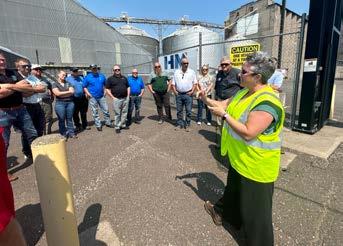


Duluth Seaway Port Authority, is optimistic about Hansen-Mueller’s potential and its willingness to handle throughput agreements — an arrangement to deliver a specified amount of product through a particular facility.
“We were missing a public-type facility,” she told farmer leaders. “The great thing about Hansen-Mueller is they’ll handle their own grain but will also take anyone’s grain on throughput. For us as the port, that’s helped us consider venturing into corn, soy and into other commodities that the port hasn’t handled in well over a decade.”
Though the port still ships about 1 million tons of grain annually – wheat and beet pulp pellets are usually

the top exported commodities – iron ore is the most popular material exported from the Port of DuluthSuperior, which first opened for commercial shipping over 150 years ago and currently brings in about 900 vessels each year.
“Hansen-Mueller is the right match for us,” Ferguson said. “It’s part of our mission to help you, the farmers, take advantage of this port.”
‘The long haul’
While Minnesota Soybean officials most recently visited Hansen-Mueller in 2023 during a visit with Moroccan buyers, the 2024 tour was most directors’ first visit to the throwback facility, which is the port’s oldest grain terminal.
“I love seeing these old elevators,” MSGA Director Brian Fruechte said. “These facilities aren’t fancy, but they’re built for the long haul.”
Standing nearly 200 feet above the bar, with a 28-foot slip depth (oceangoing ships can go through the port at 26.5-feet), the Hansen-Mueller facility can store 3.5 million bushels of grain. The site also supports nine legs and has a nearly 2,000-foot dock and on-dock rail service from BNSF Railway, which owns the land.
“We’ve come a long way and still have a long way to go,” said Sean Haasnoot, the terminal’s assistant superintendent. “But for an elevator that’s almost 120 years old, it works very well.”
Continued on page 28

The original wooden elevator was built in the 1890s; ceramic tile, brick and concrete were added in 1904. General Mills purchased the terminal in the 1940s, modernized it in the 1970s and maintained the facility before closing the elevator in 2015. It laid dormant until Hansen-Mueller renewed operations in 2022.
MSR&PC Director Corey Hanson, who farms in Norman County, remembers a time when growers in northwest Minnesota, including his father, often sent their commodities by rail to the port.
“It would be great to see this port really thrive for agriculture again,” he said. “These ports are very environmentally friendly and can help us find new routes for our beans.”
The trip to Duluth was held in conjunction with MSGA and MSR&PC’s August board meetings. During MSGA’s meeting, Rep. Paul Torkelson, a Watonwan County farmer who also serves on the multistate Great Lakes Commission, spoke of the importance of taking advantage of the Great Lakes to diversify markets for agriculture.
“This port is an economic driver for Duluth and Minnesota, and there’s a lot of room for growth here as it relates to agriculture,” Rep. Torkelson said.
In September, MSR&PC and other interested stakeholders will travel to the Port of Rotterdam in the Netherlands to learn more about the benefits of the Great Lakes compared to other trade lanes for imports and exports and underline the St. Lawrence Seaway System as an underused, sustainable resource.
“We’re really pulling for this port. It’s more important now than ever,” Slunecka said. “Our team is working hard to make the Port of Duluth really rock for agriculture.

Your joints are your connection points –and when they hurt, they stop you from moving freely. That’s why our boardcertified orthopedic specialists and surgeons use a team approach to care for you before, during and after joint replacement surgery. Our advanced partial or total joint replacement options come with less risk and shorter hospital stays, so you can safely restore your ability to move.
Find a provider at sanfordhealth.org No referral needed.



By Kelsey Barchenger
The soy checkoff continues to prioritize the expansion of international export markets. That proactive, global vision continues coming to fruition, with the summer arrival of a shipment of 150 tons of U.S. soymeal to Uzbekistan, signaling another leap forward in the Minnesota Soybean Research & Promotion Council’s (MSR&PC) sweat equity efforts to develop new trading partners.
“This is a direct result of a three-year Uzbekistan soy market development effort by the MSR&PC,” said Kim Nill, MSR&PC director of market development. “A total of six cargo containers of U.S. soymeal were recently sold to two buyer groups in Uzbekistan.”
The sale marks the second shipment of soymeal to Uzbekistan since 2022 and comes on the heels of a March 2024 trip that four MSR&PC directors, including Director Patrick O’Leary, made to the country, which is averaging 5% annual economic growth and 2% annual population growth. O’Leary returned to Uzbekistan in August alongside U.S. Ambassador to Uzbekistan Jonathan Henick and USDA Agricultural Attaché Lucas Blaustein to participate in several events preparing for the next steps in what is a budding trade relationship between the U.S. and Uzbekistan.
“Uzbekistan is a small market but a good market, with a lot of potential,” O’Leary said. “There’s a lot of desire in the country to expand their dairy and poultry production.”
O’Leary participated in a roundtable commemorating the just-announced availability of USDA GSM-102 credit guarantees to Uzbekistan buyers, explaining how its use will make future sales of U.S. soymeal to Uzbekistan buyers even easier than the current shipments.
“It’s really exciting to see the hard work and efforts that the Council has put into this becoming reality,” said O’Leary, who farms in Benson. “It’s also just exciting to see how well received we’ve been in Uzbekistan and the significant interest they have in U.S. soymeal.”
Sensing a growing demand for U.S. soy in Uzbekistan, MSR&PC has signed commitments to help foster upcoming shipments of soymeal to companies in the Central Asian country.
“The soymeal market potential of Uzbekistan is estimated to be 1 million tons per year,” Nill said. “We hope to achieve that annual level soon.”
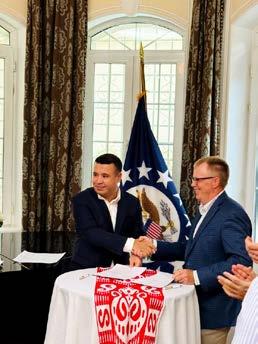
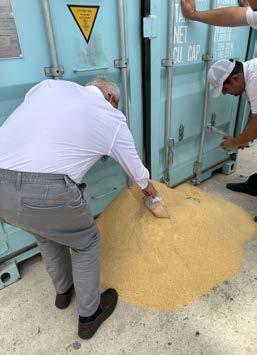


By Soybean Business staff
Minnesota Soybean’s more than 40 organized counties stayed busy this summer through various donations and event sponsorships. In turn, farmer leaders engaged with their fellow community members and highlighted how soy-based products –from straws to tires – are helping to improve rural economies and the environment while growing local connections.

“Our county program is the foundation of so much of what we do at the state level,” said Tom Frisch, chair of the Minnesota Soybean Research & Promotion Council. “So many of our projects are starting at the county level.”
“Sippin’ on soy” was a county-driven campaign that allowed county boards to donate soy-based straws throughout their counties while promoting sustainability and soy’s many value-added uses.
The United Soybean Board (USB) funded the creation of the soy straws from U.S.-grown soybeans. The straws are made from high oleic soybean oil as an alternative to traditional plastic: The oils provide increased shelf life for products in food and manufacturing. The straws are also soil and marine biodegradable after nine months.
Blue Earth County producers donated the soy-based straws to restaurants, while Redwood, Nobles and Waseca counties brought straws to the local dairy association at the county fairs. Many other counties donated to stands at their local fairs. Other counties used them at breakfast on the farm and at 4-H events.
Danimer Scientific is currently working on a checkoff-funded project with USB to make soy straws commercially available within the next year.
Southern Minnesota soybean and corn county boards kept their cool this summer through various initiatives and checkoff promotions.
For the second straight year, the Mankato MoonDogs and Rochester Honkers squared off in a rivalry series. Blue Earth County and the Olmsted-Wabasha County Corn & Soybean Growers both sponsored the rivalry series. Following the MoonDogs’ series win, the Honkers will donate to a Blue Earth County area to a charity of the MoonDogs’ choice.
Reaching a wide audience outside of the farming community is a win for the growers with the growing populations in regional hubs Rochester and Mankaato. Around both ballparks, fans saw soybean and corn messaging, and during the games, “Did You Know?” fun facts about soy and corn kept spectators guessing.
Martin County soybean farmers held their annual meeting combined with their golf tournament at the Fox Lake Golf Club. After a day on the links, the board settled down in the clubhouse to hear from checkoff leaders, including Lawrence Sukalski, who represents Minnesota on the United Soybean Board (USB).
Freeborn County held its annual meeting in conjunction with their golf day, while Faribault County also held an annual meeting in Easton.
“For our board, our annual meeting is just a great time to take a break during the growing season, visit with farmers and supporters and talk about what MSGA has done – and continues doing – on behalf of our state’s soybean farmers,” said MSGA President Darin Johnson, who farms in Faribault County.
Some organized counties hold their annual meetings during the winter doldrums, while others take advantage of summertime to hold their annual meeting with members and producers.
The Clay-Wilkin Soybean and Corn Growers were back out at the Hawley Breakfast on the Farm in June, where they gave away a set of Goodyear soy-based tires to a lucky winner and promoted soy’s countless uses. They also donated two more sets of tires to the nonprofit Farm Rescue organization for the second year in a row. In July, Secretary/Treasurer Kari Olson hosted a soil health tour on her no-till farm operation in Clay County and participated in a panel discussion.
Swift County also recently shared its appreciation for Farm Rescue. Executive Director Tim Sullivan was the guest speaker at the group’s annual meeting earlier in 2024, which inspired the board to also donate a set of soy-based tires to Farm Rescue.
Douglas County has been busy putting together plans for its first-ever Tillage Day, which will allow area farmers to see a handful of different tillage pieces in action. The event was held in late summer.
Continued on page 32
Golf events are a popular fundraising event during the summer months for county boards. Whether farmers are attending or hosting, summer days are perfect for networking and sharing a local message.
This summer, Dakota-Rice, Dodge, Faribault, Freeborn, Nicollet-Sibley, Nobles, Pipestone, Renville and Rock counties each held their respective golf events.



Kandiyohi County again promoted agriculture during the Ag Night with the Willmar Stingers baseball team. The group also tested fans’ tractor color loyalty by handing out 250 green and red tractor bobbleheads to gauge fans’ preference, but apparently the preference was split as both colors ran out at the same time.
Todd County held its annual Spring Food and Fuel giveaway, offering discounts on biodiesel and giving away soy-based groceries to customers. Each customer received vegetable oil, salad dressing and moisturizing body wash, which all include soybean oil as an ingredient.
Kittson County supported the “Farmers’ Share” supper to kick off the Kittson County Fair. The board served 350 people and distributed “Minnesoyta” sunglasses at the event. They also helped promote the county fair with a premium ad promoting livestock. The board is also compiling trivia contests across the county promoting the Behind the Dollar campaign.
Marshall County supported the Marshall County Fair with a premium ad promoting livestock and had a display and registration set up for a peddle tractor. The board donated Twin Port Respirators to nine fire departments in August and provided meat to local food shelves. They all provided crop slips with crop type, moisture, protein, weight and field number at all the local elevators. The slips were distributed to area farmers.
Norman County provided hams to their local food pantry. They continue to promote soybeans through their local radio station KRJB advertising safety, the Miracle Bean and “lunch to the farmer” program. In August, the county sponsored Harvest Days, updated their signage for the fairgrounds and again sponsored and worked at the “dinner with a farmer.” Every year the number of attendance increases. This year, they served approximately 250 community members. They board also provided agricultural children’s books to county schools.
Roseau-Lake of the Woods County delivered children’s agriculture books to the schools in Roseau and Lake of the Woods counties. The board sponsored rodeos at county fairs and promoted checkoff messaging through banners and premium ads. They also donated $350 each in biofuels to six fire departments.
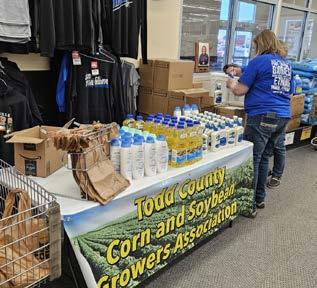
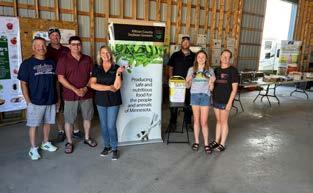
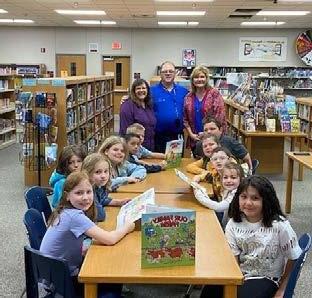
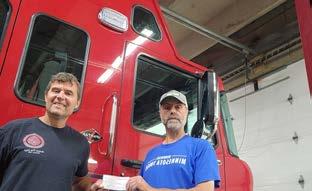
Polk County supported its county fair with sponsorships for the rodeo and by promoting livestock. They teamed up with Fosston FFA for the Polk County parade in Fertile and supported the Crookston and Fosston FFAs at their local functions by displaying “Did You Know?” soybean information. Polk County board of directors went shopping for the county food shelves in East Grand Forks, Fosston and Crookston. The county provided assorted meat valued at $350 to each food shelf.
Pennington-Red Lake County had a busy summer at the Pennington County Fair hosting a soybean pool, water with a soybean and corn messaging, color books and soy-based crayons. The board purchased a new canopy with soybean and corn logos along with banners promoting livestock. In August, the board donated $200 in fuel to six area fire departments and also provided meat to the Thief River Falls Area Food Shelf.
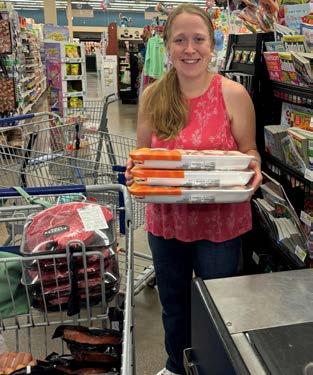
Interested in getting involved on your local county board? Contact Kaelyn Rahe at krahe@agmgmtsolutions.com for




By Bailey Grubish and Mark Askelson
With support from the soy checkoff, the lifespan of your roof’s shingles is primed to expand.
Homeowners are used to getting roughly 20 years out of their shingles and then facing the expensive reality of replacing them all.
But with soy-based products such as Roof Maxx or RoofRestor, reality is changing and helping save homeowners money and adding value to Minnesota soybeans.
“My husband, Brad, and I are really excited about utilizing this product on our home because it’s an investment, but it’s a lot less investment,” said Rochelle Krusemark, a Minnesota Soybean Research & Promotion Council (MSR&PC) director and Trimont farmer. “What I’d like to share is that the cost of this rejuvenation for this square footage is about one-fifth to one-sixth of what it would have cost to put new shingles on this roof.”
MSR&PC and the Agricultural Utilization Research Institute (AURI) hosted demonstrations this summer for the pair of soy-based roof rejuvenating products. The Roof Maxx demonstration was conducted in Thief River Falls while the Roof Restor demonstration was held at the
Krusemark’s lake home in Fox Lake. In both cases, the shingles were approximately 20 years old, but after the applications it could last for another 5-10 years.
Completing the project on the 5,200 square-foot roof at Rochelle Krusemark’s lake home used the equivalent of 10.4 bushels of soybeans.
“The reason why Brad and I wanted to use this product is first of all, we’re farmers and we grow soybeans and secondly, I voted to invest soybean checkoff funds for these products,” Krusemark said. “I wouldn’t be very credible if I wasn’t willing to use it on my own shingles.”
The soy methyl ester emulsion (SMEE) roof sealant product used by both Roof Maxx and RoofRestor, was developed from a product that’s an asphalt rejuvenator. This soy-based rejuvenator is emulsified and sprayed onto the roof to soak in over 48 hours. The application replenishes the petrochemical oils that evaporate over time, which restores the shingle’s flexibility, extends its life and enhances its ability to withstand the elements.

is just another example of a

“The petro oil in asphalt shingles will leach out over time, leaving it dry and brittle. What we’re doing is putting soybean oil back in to make it pliable and flexible,” said Mathew Schad, owner of Roof Maxx of Grand Rapids.
Saving money, reducing carbon footprint
Along with the substantial cost savings from using the SMEE product on roofs, the environmental benefits are also driving the conversation. Roof Maxx and Roof Restor are both a food-grade, plant-based product that’s safe for people, pets and plants. By prolonging the life of roof, customers are reducing the number of asphalt shingles in the landfill.
“Attempting to recycle asphalt shingles is an extremely carbon-intensive process and most of the time they just end up getting buried in landfills,” said Harold Stanislawski, business and industry development director for AURI. “So, the best solution is to keep them on the roof as long as possible by using a soy rejuvenate.”
According to a recent study by Ohio State University, approximately seven percent of U.S. roof shingles are replaced each year. The study found that 5.6 billion pounds of landfill waste could be avoided each year, plus 1.1 million metric tons of carbon dioxide equivalent in emissions, if only one percent of single-family homes
(about 15 percent of annual replacements) applied a SMEE product to their roof shingles.
This project started with funding from soybean checkoff programs across the nation. MSR&PC Director Corey Hanson, who farms near Gary, drove up to see his checkoff dollars in action at the Roof Maxx demonstration in northern Minnesota.
“This is just another example of a great use for our Minnesota soybeans and your checkoff dollars at work creating new demands,” said Hanson. “It just once again shows the versatility of soybeans. From paints to biodiesel to soybean meal for livestock and now soy-based lawn fertilizer, the list of uses for soybeans continues to grow.”
For homeowners, it comes down to saving money and saving the planet. The soy-based Roof Maxx product checks both of those boxes, Hanson said.
“There are millions of homeowners across the country with asphalt shingles who could save money and the environment by using a soy rejuvenate to extend the life of their roof,” Hanson said. “As a soybean farmer, that’s pretty exciting to think about.”
By Mark Askelson
Wherever a farm is experiencing a crisis, Farm Rescue will be there. Whenever a natural disaster strikes a farm community, Farm Rescue will be there. If a farm family needs a helping hand to ensure it continues for more generations to come, yes, you can bet Farm Rescue will be there.
Soaring high above in the skies in a Boeing 747 as an airline captain for UPS, Bill Gross had a good view of the farming landscape in the Upper Midwest. Growing up on a farm in North Dakota, he understood the financial risks and hardships of running a family-owned operation. To give back, Gross founded Farm Rescue in 2005 with a vision of helping family farms and ranches endure crises and have the opportunity to continue operating and pass the farm on to the next generation. Gross gathered a handful of volunteers, borrowed some equipment and got to work.
Nearly 20 years later, Farm Rescue has served more than 1,000 families through unexpected illness or injury and disaster. Initially beginning rescues in the Dakotas and Minnesota, Farm Rescue soon expanded its footprint into Corn Belt states in 2011, growing from roughly a dozen cases a year to an average of 75 cases. Today, they average between 80-120 cases annually. In addition to
on-farm assistance, Farm Rescue also answers the call when natural disasters hit rural areas.
“We step in with our volunteer base and our sponsored equipment and we take care of the needs on their farms,” said Tim Sullivan, Farm Rescue’s senior development officer. “Anything we can do to keep their livelihood afloat while they get through their crisis.”
When Mike Powers, who farms corn, soybeans and beef cattle near Mankato, suffered a stroke in the spring of 2021, he needed time to recover and couldn’t yet operate machinery heading into the planting season. His family reached out to Farm Rescue and was swiftly approved to get the help they needed to get a crop in the ground.
“It was such a relief to have their assistance. They were in and out in twothree days and did an amazing job,” Powers said. “Without their help I would’ve been lost. It saved this farm, it really did.”
Angels in blue
It can be logistically difficult to assist farmers in multiple states at the same time with sometimes similar and sometimes different needs. One farm family
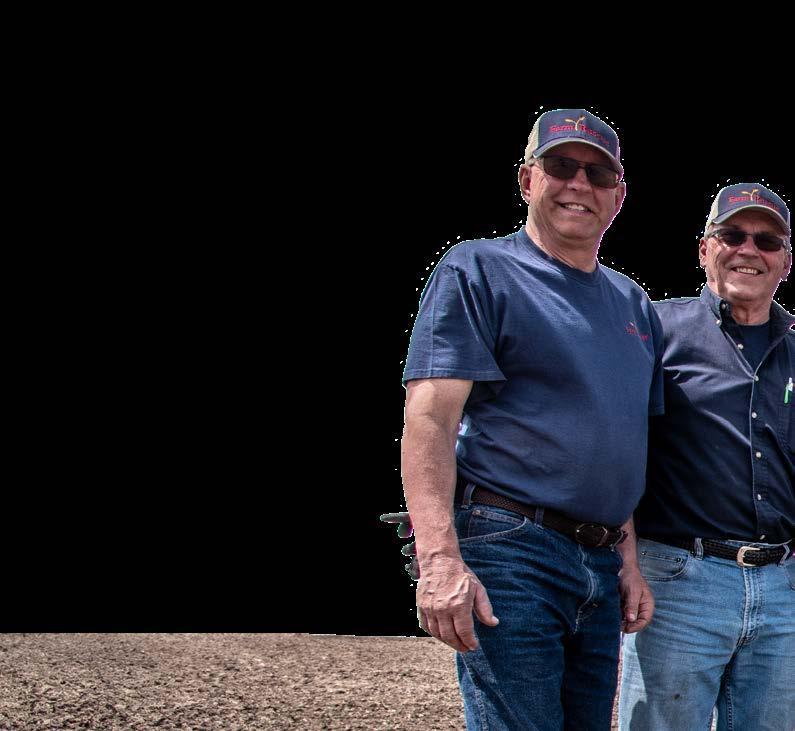
may need help with a soybean harvest in Minnesota, while another may need an emergency load of hay in Missouri. But with multiple hubs for storing equipment and an army of angels in blue, a nickname given to their over 700 skilled volunteers and their signature blue work shirts, the superheroes at Farm Rescue always seem to find a way to get it done.
“You won’t find a more humble group. They do this purely out of the kindness of their heart, and they aren’t looking for any recognition of their own. It’s all about the families that they’re helping,” said Sullivan. “That’s what drives our staff, is seeing how much these folks give. They truly are angels in blue.”
But just like any farming operation, Farm Rescue and their volunteers are not immune to the hazards of farming.
“We still have setbacks and delays,” Sullivan said. “We can’t control what Mother Nature has in store for us and
although we are working with new equipment, there are still some minor break downs and such to deal with.”
The success and growth of Farm Rescue has happened organically over the years with their work speaking for themselves. Farm Rescue currently operates in North Dakota, South Dakota, Minnesota, Illinois, Iowa, Missouri, Montana, Nebraska and Kansas. Now this summer they are preparing to begin deploying Farm Rescue teams in Wisconsin for the first time ever. In the future they hope to expand their assistance further east.
Expanding to a new state takes time, on average about two to three years to acquire funding, acquire equipment and line up volunteers. Sullivan estimates that in the next five years, Farm Rescue could very well double in size.
“Our sponsors and supporters want us to continue to grow and they are willing to help us to do that,” he said. “Finding volunteers is actually the easy part because there are so many people willing to serve
our organization as word has gotten out about what we are doing.”
As a nonprofit, Farm Rescue relies solely on sponsorships and donations to keep them going down the road. Many of those sponsorships are in-kind, such as the tractors and combines they use in the field, the pickups and trucks they drive down the road, and sometimes even the tires on those vehicles. In summer 2023 and 2024, the Clay-Wilkin County Soybean & Corn Growers used soy checkoff funds to donate multiple sets of soy-based Goodyear tires to Farm Rescue to help them get down the road.

“Many farms in our area are on their fourth, fifth or even sixth generation, and Farm Rescue is there to help families ensure they have a crop in the ground or the bin during times of crisis and can pass the farm on to the next generation,” said Board President Jeremy Tischer, who farms in Breckenridge and serves as a director with the Minnesota Soybean Growers Association. “Farm Rescue supports farmers, and these soy-based tires support farmers as well. It’s a winwin for everyone.”
To learn more about Farm Rescue’s mission or to apply for assistance, visit farmrescue.org

Minnesota Soybean Research & Promotion Council (MSR&PC) Chair Tom Frisch knows how soy checkoff resources work Behind the Dollar to boost his profitability. In this Q&A, learn more about Tom and his thoughts on the long-lasting impact of soy checkoff investments.
This interview has been edited for length and clarity.
Q: Give us a quick background on your farm.
Tom Frisch: It’s a family farm, fourth generation and we grow soybeans, corn and alfalfa. I farm with three cousins in westcentral Minnesota.
Q: Which region of the state do you represent on the Minnesota Soybean Research & Promotion Council? How long have you been on the board?
TF: I’m in District 4 and starting my sixth year.
Q: Why did you decide to run for the Minnesota Soybean Research & Promotion Council?
TF: Just because I really didn’t know much about the soybean checkoff. I didn’t know much about the Council. I thought the best way to learn is to get involved.
Q: Why do you feel the checkoff is critical to Minnesota’s soybean farmers?
TF: Through helping with research and helping work collaboratively with universities, private industry, bringing it all together from production agriculture and research to investments. All of this is to help farmers grow the supply side and the demand side by trying to find and open new markets to increase demand for soybeans to help keep prices stable.
Q: How does the board ensure checkoff dollars are invested responsibly?
TF: The soybean checkoff dollars are directed by farmers themselves. Farmers are elected through the process by the Minnesota Department of Agriculture. We have open, transparent board meetings. We spend a ton of time going over each project, vetting the projects – pros, cons, how much value brings back to Minnesota soybean farmer – before any investment is made.
Q: How has directing checkoff funds raised your awareness of the soy checkoff ?
TF: Just seeing how the process works has been the best part and most informative part. I know that it’s a long process before any soybean checkoff dollars are invested. We make sure that we cross all our T’s, dot all our I’s and make sure that it’s a good investment.
Q: What project(s) are you most proud of that you have seen since being on the board?
TF: Every year is a little different. I think getting six containers to Uzbekistan of U.S. soymeal is a big deal. That is a market we can open up and increase and get more over there.
Ag in the Classroom is another super important investment the Council makes. Educating on the checkoff and agriculture are a part of what the Council does for the soybean checkoff, as well as educating on agriculture issues.
Q: Many checkoff investments are made to impact our future growers. As someone who also sits on the United Soybean Board (USB), what are some checkoff-supported projects coming down the pipeline that you’re excited about?
TF: One project I’m really excited about is a USB project following the process to help a company develop a soy-based chemistry curriculum for college courses.
We’re also continuing to work with Uzbekistan and highlight the benefits of northerngrown soybeans and how they’re more beneficial to animals. The new research, there’s always something new coming out that helps farmers with increasing yields. And hopefully we can get that out to the farmers faster.
Q: What do you think is the biggest misconception other farmers have about the soy checkoff program? How would you respond to their concerns?
TF: Farmers don’t always fully understand what the soybean checkoff does. I just think that people don’t understand what the checkoff is about or what it does. That’s why this Behind the Dollar campaign is great to get some more education or at least it steers them in the right direction of who they can get a hold of and ask them to explain what it is.
Q: Where can another farmer go to get more information on how their dollars are being spent?
TF: They can go to the website, or they can go find out who their representative is on the checkoff board. They can call the office, and the office will answer questions if they can, or will direct farmers to someone who can answer the questions.





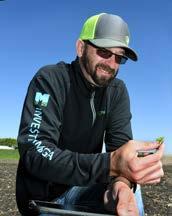

MSGA is searching for growers to represent Minnesota soybean farmers and apply for the Young Leader program, which has identified and trained soybean farmers to be leaders in the industry for more than 40 years. Phase I of the 2024-25 Young Leader program will take place Dec. 2-5 at Corteva’s Global Business Center in Johnston, Iowa. It continues Feb. 28-March 4, 2025, in Denver in conjunction with the annual Commodity Classic Convention and Trade Show.
Applications are now open through Sept. 20, 2024. Soybean growers – both individuals and couples – of any age are encouraged to apply: The program, which is supported by the Minnesota Soybean Research & Promotion Council and the soy checkoff, is designed for those young in their leadership careers.
Visit soygrowers.com to apply.
MSGA director included in Congressional Record
Bob Worth’s legacy of advocacy is set in stone.
Following a biofuels panel in Minneapolis featuring congressional leaders, USDA Sec. Tom Vilsack, Ag Commissioner Thom Petersen and MSGA Director Jamie Beyer, Rep. Angie Craig surprised Worth by informing him his lasting contributions to agriculture are now enshrined in the Congressional Record Index.
“I am thankful for our strong working relationship during his time with MSGA,” Craig said in her remarks on the House floor. “Thanks to the hard work from leaders like Bob, Minnesota became the first state to require biodiesel in our fuel blends.”
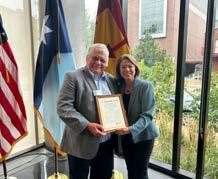
Worth, a current director and past MSGA president, said the recognition left him speechless.
“I am so humbled to receive this honor,” he said, “but it is the whole MSGA team that deserves credit.”
Four Minnesota farmers joined their colleagues on the United Soybean Board (USB) in putting their stamp of approval on the organization’s 2025 fiscal year budget, which amounted to $173.8 million for the coming year. The budget supports research, promotion and education investment portfolios selected through USB’s Portfolio Development Process. These investments drive demand for U.S. Soy and return value to all U.S. soybean farmers. The total budget figure also includes execution, oversight and program support.
Director Tom Frisch serves as USB’s workgroup lead for the infrastructure & connectivity demand priority area. One project he’s most excited about is developing a soy-based chemistry curriculum that could be taught to post-secondary students.
“This will allow us to get to the future workforce earlier so that they start with using soy as a base instead of having to reengineer a current product to fit for soy,” Frisch said.
Martin County farmer Lawrence Sukalski, who serves on USB’s executive committee, said that grower leaders are targeted in their approach to spending checkoff dollars wisely.
“We obviously have more of the supply than demand right now, so we tended to lean our funding priorities towards the side of demand to create new markets and move some soybeans,” he said.
Gene Stoel and Patrick O’Leary also represent Minnesota on USB.
MN Ag Expo returns
Mark your calendars: The
2025 MN Ag Expo returns Jan. 22-23 to the Mankato civic center. Organized by MSGA and Minnesota Corn, MN Ag Expo looks toward the future by offering networking opportunities; business meetings and educational sessions; a full trade show floor; dynamic speakers; fundraising events – and more!

2025 MN Ag Expo Jan. 22-23, 2025 Mankato, MN mnagexpo.com
The 2025 agenda continues taking shape, but a keynote speaker has already been announced. Rob Sharkey, aka the Shark Farmer, will bring his authentic and outside-the-box brand of storytelling to Minnesota’s farming community. Sharkey, who will speak Wednesday, Jan. 22 at Expo, isn’t afraid to address controversial topics or share the struggles of being a modern farmer and business owner. His unfiltered words resonate with almost 1 million listeners weekly around the world on his Sirius XM Rural Radio show.
Registration is now available for the free, two-day conference and event at mnagexpo.com. Stay tuned for more agenda news in the months ahead.

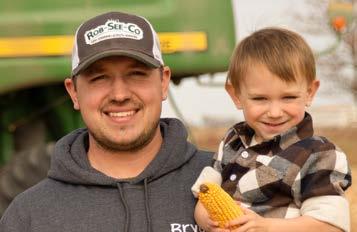
Being determined and a hard worker are valuable traits for McLeod County farmer Bryce Lindeman.
He grew up on a cash and canning crop farm, raising soybeans and corn, along with growing sweet corn in partnership with Seneca. With a background in agriculture, Lindeman earned a degree in agronomy from South Dakota State University.
“After graduation I decided to do crop consulting for a while,” Lindeman said. “Then I eventually became a district sales manager for Rob-See-Co for southern Minnesota.”
Lindeman continues to farm with his father, Bob, who’s a director with the Minnesota Soybean Growers Association (MSGA). Bryce farms some of his own land. Off the farm, Bryce is a firefighter for the Brownton Fire Department.
“Being able to work hard and have a good work ethic always seems to pay dividends, whether it being in adding character or presenting new opportunities for future endeavors,” he said. “It is also good to take time off to volunteer or even spend time with your family to maintain relationships with your spouse and others.”
He has also been active on his county corn and soybean board for the last two years. He also participated in MSGA’s Young & Emerging Farmer Workshop at the 2024 MN Ag Expo.
“It is important to become a member of MSGA because there are many behind the scenes aspects that we do not see,” Lindeman said. “They are fighting for farmers and adding sustainable avenues for us. The collective power MSGA holds, and the legwork they do with Congress is all so vital and important.”

Third-generation farmer Michael Buer farms in Meeker County near Grove City.
During this year’s Farmfest, he became a member of the Minnesota Soybean Growers Association.
“It seems like there’s a complete lack of support for the American farmer,” Buer said on why he joined. “I just thought we have to do what we can to promote ourselves.”
He farms full time with his wife, Christine, with the help of their three sons. The Buers grow soybeans, food-grade soy and corn. Buer bought the family farm from his dad almost 17 years ago after buying his first farm at the age of 21.
As a youngster, his path was to become a diesel mechanic, but things changed, and he started farming full time after post-secondary at technical college.
“There’s a lot of respect and admiration for my father and mother and grandfather,” Buer said of being able to continue as a generational farmer. “I don’t take any of it for granted. It’s not about the numbers. It’s not about the value of the farm. It’s the way of life. And like I said, it’s not the value of the land, it’s the ability to use it as a tool to create an income for us.”
Off the farm, Buer volunteers at his church, the Boy Scouts and serves as Swede Township’s supervisor. He’s also involved in 4-H and school activities with his sons.
The Minnesota Soybean Growers Association (MSGA) salutes the 51 new members who joined MSGA during summer 2024. We also extend our appreciation to the 91 producers, industry professionals and supporters who renewed their membership since June. Thanks to your support, we signed up 63 members at Farmfest, the most in MSGA’s history!
With a critical state and federal election just weeks away, our work continues throughout the fall. Our advocates and lobbying team continue pounding the pavement in St. Paul and Washington, D.C., to
Member County Noah Ziegler Blue Earth
Mark Gutierrez Carlton
Nathan Hesse Cottonwood
Aaron Johnson Faribault
Lexi Johnson Faribault
Rachel Johnson Faribault
Tyra Johnson Faribault
Dustin & Steve Lindstrom Goodhue
Josh Finnesgard Goodhue
Perry Dohrn Goodhue
Shannon Haugen Goodhue
Tom Henderson Goodhue
Adam Callstrom Goodhue
Lena Dziechowski Hennepin
David Goblish Lyon
Ellie Goblish Lyon
Jameson Mackenthun McLeod
1 Year Membership: $120
I
(with
promote our policy priorities, with one united objective in mind: protecting the profitability of Minnesota soybean farmers.
Visit us Sept. 10-12 at Big Iron in West Fargo, N.D., in booth #C9-C10 to meet our team and receive exclusive swag when you renew your membership or join MSGA.
To support your industry by becoming a member of the nation’s premier state soybean association, visit mnsoybean.org/msga/invest. Membership levels start at just $20 for students, and a 3-year membership costs just 22-cents per day!
Member County
Jon Dahlke McLeod
Scott Marshall McLeod
Michael Buer Meeker
Jim Kluis Murray
Travis Reith Murray
Andy Nelson Murray
Jeffrey Franta Nicollet
Phil’s Repair Nobles
Sean Haberman Nobles
Tri State Rental Center Nobles
Tru-Shine Truck Wash Nobles
Derek Erlandson Nobles
Mark Lorang Nobles
Randy Buntjer Nobles
Eivind Jore Pennington
Kayla Jore Pennington
Mathea Jore Pennington
Member County
Michael Reese Pope
Alfie Duerr Ramsey
Camilla Goblish Redwood
George Goblish Jr. Redwood
Josh Nelson Redwood
Luke Goblish Redwood
Vivian Goblish Redwood
Robin Stamer Renville
Jared Pick Rock
Joey Pick Rock
Nick Bork Rock
Beth Wendinger Sibley
Neal Harder Sibley
Tronn Tosel Swift
Brody Morrow Traverse
Jason Beyer Traverse
Jason Stenzel Waseca




To help cover the start-up costs of cover crops, Farmers for Soil Health o ers financial assistance of up to $50/acre over a three-year period.
Enrollment in Farmers for Soil Health provides access to an exclusive future marketplace connecting farmers to top-tier supply chain partners that are focused on sustainability.

Each state has dedicated on-theground technical advisors to provide research-based information and educational resources to aid in the transition of your field.
